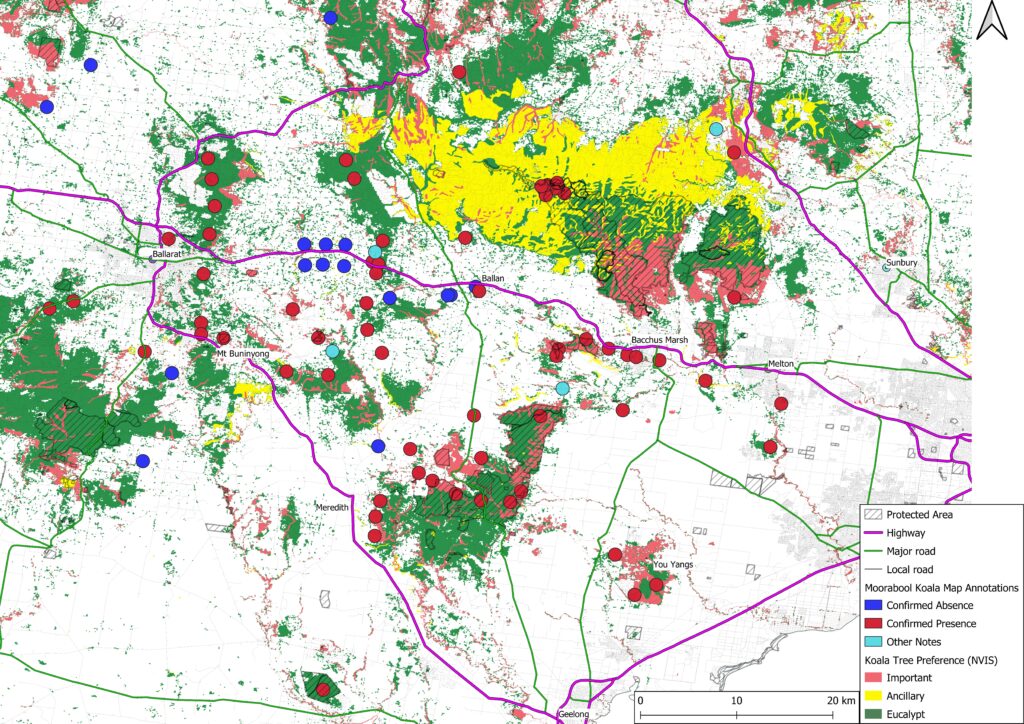Moorabool Koala Count Co-Design Workshop
The co-design workshop
On July 14th 2022, a co-design workshop was held at the Ballan Mechanics Institute and Bostock Reservoir for the Moorabool Koala Count Project with Moorabool Catchment Landcare Group, Wadawarrung Traditional Owners Aboriginal Corporation (WTOAC), and CSIRO. There was a fantastic turnout from the community, with 36 people attending including a number of representatives from environmental groups in the area.
This web page has largely borrowed from the workshop summary report prepared by the CSIRO. You can find the full report below.

Local knowledge combines with innovative science
At the workshop, we used potential koala habitat maps prepared by CSIRO and the local knowledge of participants to produce a collaborative map of potential koala populations in the Moorabool area (see map below). We worked together in groups to map areas where people know there are koalas (confirmed presence, red dots) and where koalas were once but are no longer found (confirmed absence, blue dots). There is a strong correlation between local knowledge of koala presence and where there is good habitat. This map will be helpful for deciding on areas to establish monitoring transects.

Collaborative map of potential koala populations in the Moorabool catchment produced by workshop participants and CSIRO researchers.
Participant survey
We used a survey to understand the value of koalas, the value of monitoring, and the value of the co-design and collaboration process to participants of the workshop. We know how important koalas are to the Moorabool community – they are a unique, charismatic, and iconic species that people love to see on their properties and in surrounding bushland. When there is a good population of koalas, it tells people that country, the environment, biodiversity, and habitats are healthy. There is concern that the numbers of koalas in the area are declining.
- In summary the survey revealed:
- Participants are keen to be involved in monitoring koalas, with many already doing so as citizen scientists on their own properties or through Landcare and other groups.
- Most people spend one hour per week monitoring koalas, but a few spend more than a day a week by walking daily and always listening. As one person said, ‘not seeing [koalas] is also monitoring.’
- There are strong skills in the group already, with 13 with high and 12 with medium capacity to monitor.
- Even where people have low or low-medium skills, many are enthusiastic to participate and learn, especially how to identify koalas through scats and scratches.
- People are motivated to participate in monitoring and collect data to get a better idea of where koalas are in the area and what is happening to them, increase community involvement in koala management and habitat conservation efforts, and contribute to the national conversation about the species.
- Participants thought there was value in using a collaborative approach to monitoring, to ensure an accurate picture of what is happening in the area by getting better consistent data, covering a large survey area, using a range of information, and raising awareness by getting the community involved and sharing information.

Monitoring training
In the afternoon we went to Bostock Reservoir to learn some monitoring approaches, including double count surveys where we identify koalas by looking for them in trees, listening for their calls, and look for scratch marks in trees and scats on the ground. While we did not see any koalas, we talked about how important it is to report when there are no koalas, because this helps us understand not just where koalas are, but also where they are not. We call this being a zero hero!
What next? How can you contribute?
If you missed out on our workshop there are still plenty of opportunities to be a part of the Koala Count. We are currently looking for people to contribute any way they can. iNaturalist observations, scat detections, historical data, or transect surveys. Anyone can contribute data to this project. Every bit of data we collect means a better future for the iconic Koala.